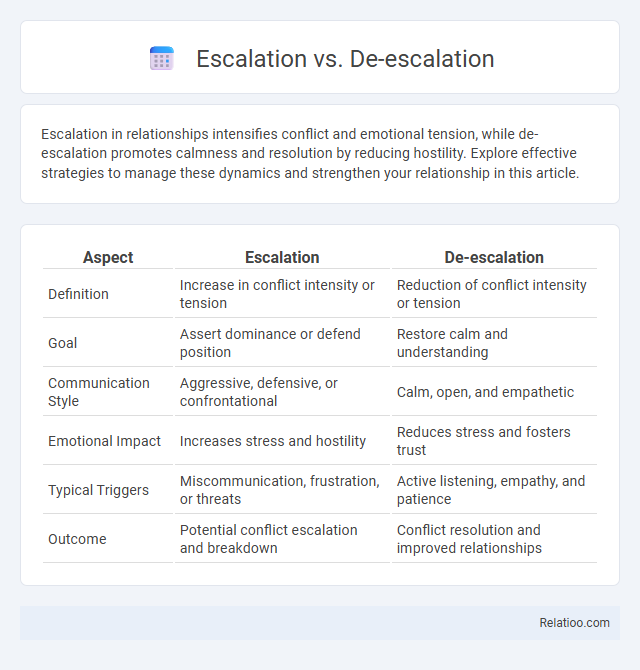Escalation in relationships intensifies conflict and emotional tension, while de-escalation promotes calmness and resolution by reducing hostility. Explore effective strategies to manage these dynamics and strengthen your relationship in this article.
Table of Comparison
| Aspect | Escalation | De-escalation |
|---|---|---|
| Definition | Increase in conflict intensity or tension | Reduction of conflict intensity or tension |
| Goal | Assert dominance or defend position | Restore calm and understanding |
| Communication Style | Aggressive, defensive, or confrontational | Calm, open, and empathetic |
| Emotional Impact | Increases stress and hostility | Reduces stress and fosters trust |
| Typical Triggers | Miscommunication, frustration, or threats | Active listening, empathy, and patience |
| Outcome | Potential conflict escalation and breakdown | Conflict resolution and improved relationships |
Understanding Escalation and De-escalation
Escalation involves intensifying a conflict or situation, often resulting in increased tension and potential harm, while de-escalation focuses on reducing hostility and calming emotions to prevent further conflict. Understanding escalation helps identify triggers that amplify disputes, enabling you to intervene early, whereas mastering de-escalation techniques promotes conflict resolution and peaceful outcomes. Balancing these concepts is essential for effective communication and maintaining control in challenging scenarios.
Key Differences Between Escalation and De-escalation
Escalation involves increasing the intensity or severity of a situation, often characterized by heightened conflict or urgent responses, while de-escalation aims to reduce tension and restore calm through communication and conflict resolution techniques. Key differences between escalation and de-escalation lie in their objectives: escalation intensifies the issue, potentially leading to crisis, whereas de-escalation seeks to prevent harm and resolve disputes peacefully. Your ability to recognize these dynamics enables effective management of conflicts in various environments.
Causes and Triggers of Escalation
Escalation occurs due to unresolved conflicts, miscommunication, or perceived threats, often triggered by emotional responses and power struggles. De-escalation aims to reduce tension by promoting understanding, active listening, and calming techniques to prevent further conflict. Re-escalation happens when attempts to de-escalate fail, causing renewed hostility or intensified disputes.
Psychological Principles Behind De-escalation
De-escalation relies on psychological principles such as empathy, active listening, and maintaining calm to reduce tension and prevent conflict from worsening. Your ability to recognize emotional triggers and respond with non-threatening body language, tone, and words helps shift the interaction toward resolution. Understanding these dynamics contrasts with escalation, which intensifies conflict, and highlights how effective psychological strategies promote safety and cooperation.
Common Scenarios Requiring De-escalation
In high-pressure environments such as customer service, healthcare, and law enforcement, common scenarios requiring de-escalation include confrontations involving anger, confusion, or distress. Techniques like active listening, calm communication, and empathy help reduce emotional intensity and prevent conflicts from escalating further. Effective de-escalation minimizes risks, fosters cooperation, and restores control in volatile situations.
Effective Escalation Techniques (When Necessary)
Effective escalation techniques involve clear communication, prompt identification of issues, and structured protocols to ensure timely resolution while maintaining professionalism. De-escalation methods focus on calming tensions through active listening, empathy, and non-confrontational language to prevent conflicts from intensifying. Balancing escalation and de-escalation requires situational awareness and strategic decision-making to address problems efficiently without exacerbating stress or misunderstandings.
Proven De-escalation Strategies and Methods
Proven de-escalation strategies prioritize active listening, empathy, and maintaining calm body language to reduce tension effectively. Techniques such as controlled breathing, reflective statements, and offering clear choices help shift confrontational dynamics toward resolution. Implementing these methods consistently prevents escalation and fosters cooperative communication in conflict situations.
The Role of Communication in Escalation vs De-escalation
Effective communication plays a critical role in both escalation and de-escalation processes by shaping how conflicts intensify or resolve. Clarity, tone, and empathy in your communication can either escalate tensions by fostering misunderstandings or de-escalate situations by promoting calm and mutual understanding. Your ability to carefully choose words and listen actively influences whether conflicts spiral out of control or move toward resolution.
Escalation and De-escalation in Conflict Resolution
Escalation in conflict resolution refers to the process where tensions increase, often leading to more intense disputes, while de-escalation aims to reduce hostility and promote peaceful communication. Your ability to recognize early signs of escalation and implement de-escalation techniques, such as active listening and empathy, significantly impacts the outcome of conflicts. Effective conflict resolution depends on managing escalation to prevent harm and fostering de-escalation to restore understanding and cooperation.
Building Skills for Managing Escalation and Promoting De-escalation
Building skills for managing escalation involves recognizing early signs of conflict and employing effective communication techniques to prevent situations from intensifying. Strategies such as active listening, empathy, and maintaining a calm tone promote de-escalation by reducing tension and fostering mutual understanding. Training in conflict resolution, emotional regulation, and problem-solving enhances the ability to balance escalation and de-escalation dynamics for positive outcomes.

Infographic: Escalation vs De-escalation
 relatioo.com
relatioo.com